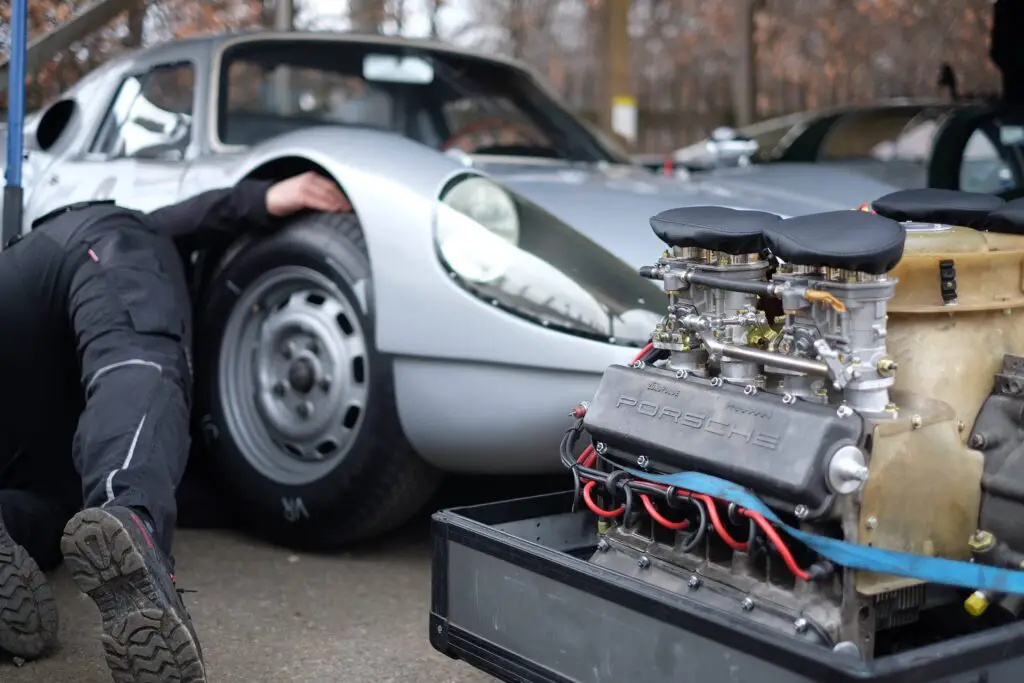The catalytic converter is responsible for reducing harmful emissions from the atmosphere. Ever since it has been added to vehicles, there has been less pollution in major cities around the world. But what is in a catalytic converter that lowers the emission of harmful pollutants? The answer is – rare metals that react with the emissions. You’ll find more information about the rare elements of the catalytic converter in this blog and why many people steal the device because of them.
What Is a Catalytic Converter?
Every car today has a catalytic converter, and the technology behind it is not new at all. Ever since the introduction of catalytic converters into the automotive industry and technology, major cities around the world have had cleaner air. It is one of the most vital additions in the car evolution. This is because the purpose of this part is to use different chemical reactions and thus get rid of the harmful and poisonous exhaust emissions produced by the vehicle. It is located on the vehicle’s underside as a part of the exhaust system. You will find it between the muffler and your exhaust manifold.
Why Are Catalytic Converters So Important?
Gasoline is made up of hydrocarbons, and when the combustion in the car occurs properly, all of the carbons, hydrogen, and oxygen produce water and carbon dioxide. However, the combustion in a car’s engine isn’t always perfect, some reactions are not complete, and the process ends up creating molecules that don’t generally occur, such as carbon monoxide.
Additionally, the heat increases nitrogen, which reacts with oxygen and creates multiple combinations that are harmful to our health. This is why every car needs a catalytic converter. It will reduce harmful emissions and control the problem.

What Is in a Catalytic Converter?
Elements that are found in the catalytic converter help convert the emissions from the exhaust emission system and make them less toxic and safer.
But, first and foremost, I have to mention ceramic. It is present in the converter, but doesn’t react with any elements. Its main purpose is to enable the reactions by staying really hot. Individuals who are taking their vehicles for an emissions test should know that their converters need to be hot for the test to work.
Then, rare metals are the key components that are inside the catalytic converter, and these are platinum, palladium, and rhodium. They are responsible for the conversion of toxins and harmful gases.
How Do Reactions Take Place in Catalytic Converters?
The process of converting poisonous gases is quite simple. First, the gases reach the converter and flow through a ceramic structure that is found inside. This structure is coated with catalysts, so when they react with emissions, they successfully convert the gases into less harmful elements.
Generally, rare elements react with nitrogen oxide. They remove oxygen from nitrogen, creating just oxygen and nitrogen – less harmful gases. Next, the common occurrence is oxidation. The elements convert carbon monoxide, which endangers our ozone layer, into carbon dioxide, which is safer.
Also, the unburned hydrocarbons are turned into water and carbon dioxide. When the reactions are completed, we mostly get nitrogen, oxygen, water, and carbon dioxide released from the emission system.

The Rare Elements Inside the Converters Are the Reason for Frequent Thefts
There are more and more incidents of thefts involving catalytic converters. In the United States, about 50,000 converters were stolen in 2022, from January to September. Sometimes these situations can turn violent. This is a huge difference from the previous year, when there were 14,433 reposts of catalytic converter thefts. The main reason for this is the metals found in the catalytic converters. The platinum, palladium, and rhodium are each worth approximately $30 per gram.
Inside the catalytic converters, there are about three to seven grams of them. When they get stolen and shipped internationally, the metals inside get recycled. The owners, on the other hand, end up in need of a replacement which can be a bit pricey. It is estimated the average replacement cost is $1,500. This price is inflated because of the frequency of thefts, and the process is not as easy as changing a tail light.

Types of Catalytic Converters
There are three types of catalytic converters that you may find in the cars that are driven on the roads today. There are some differences between them, which mainly revolve around the issue of eliminating nitrogen oxides. The more successful and efficient types are the ones that can remove them more easily. Here is a list of different types that you need to differentiate between.
OC – Oxidation Catalyst
When a vehicle has this type of converter, the HC and CO will react with oxygen, and water, as well as carbon dioxide, will be produced. These elements are not pollutants. The requirement for oxidation to occur is air in the exhaust manifold. Also, the exhaust emissions need to circulate back to the EGR system since it will help lower the number of nitrogen oxides.
TWC – Three-Way Catalyst
This is the best version of all catalytic converters. It doesn’t only convert HC and CO, but it is instrumental in converting nitrogen oxides into elements that are not toxic or harmful. The nitrogen oxides will be converted through oxidation into oxygen and nitrogen, while HC and CO will end up converted into H2O, N2, and CO2.
TWC-OC – Three-Way Catalyst & Oxidation Catalyst
This version is a combination of the first two types of catalytic converters. It is designed to be even more efficient at reducing pollution.
Are Catalytic Converters Effective in Reducing Air Pollution?
Actually, catalytic converters significantly reduce harmful emissions, and the most effective converters are three-way catalysts. They are successful at reducing local pollution, i.e., less dirty air in the location you are driving. However, people usually wonder if they are as eco-friendly as they appear to be. Still, it should be emphasized that they are instrumental in lowering emissions, and nobody should think about getting rid of them completely.
The truth is that for the process to work, the engine needs to warm up. As I have mentioned earlier, the catalytic converter needs to stay hot. The older versions of this device required approximately 15 minutes to become warm. This means that they were not effective for the first couple of kilometers. However, our vehicles today don’t need as much time. They warm up in under 3 minutes.
The Big Volkswagen Scandal Brought Attention to the Importance of Catalytic Converter Working Properly
The Volkswagen scandal from 2015 concerning cheating on the emissions test involved over 600,000 cars in the United States. At first, it was thought that the vehicles met the US standards for harmful emissions, but when they were sold and driven, it was discovered that they emitted 40 times more nitrogen oxides than it’s permitted. This drew attention to the catalytic converter’s importance and design. To fix the problem, manufacturers decided to change the design of the converter so that it would be more efficient at reducing emissions.

What Are the Clear Signs That Your Catalytic Converter Needs to Be Replaced?
The catalytic converter is one of the more sensitive parts of every vehicle. Even though it is designed to last a long time, this usually is not the case. The honeycomb shape inside the converter will have a lot of residue from the gases that go through it on a regular basis. One of the frequent issues is clogged catalytic converters that cannot process any more emissions. You might encounter this problem if you have been driving a used car for a while. Here are the most common signs that you need to replace your catalytic converter:
- Dark smoke coming from the tailpipe – When the catalytic converter is clogged, the gases will not easily exit through the tailpipe. This buildup will cause the smoke to be darker and thicker.
- The check engine light will signalize a problem – The check-engine light can illuminate for multiple reasons. However, if there seems to be nothing wrong with other parts of the car, such as the car’s battery, the engine, the spark plug, or the oxygen sensors, the catalytic converter might be bad. Have a mechanic inspect the vehicle.
- An unpleasant smell – You will notice an unpleasant smell while driving in your car when the fuel builds up as a result of a clogged converter.
- The gas mileage of your car has dropped significantly – This cause, together with other signs, can indicate a failing catalytic converter. Reduced airflow from a clogged converter makes your engine use more fuel. This not only drives up your fuel costs and waste gas, but it also exacerbates the clog.
- There is a rattling noise coming from the underside of the car – A sure sign that you need to have someone look at your vehicle a bit closer is a noise coming from the underside. When the converter is damaged, the honeycomb structure can collapse. The rattling noise that you hear upon starting the car might be the device that has collapsed and is now vibrating.
Have you noticed some of these signs on your car? Unfortunately, drivers who encounter this problem cannot repair the car but need to resort to mechanics that can only replace the device. The process is not as easy as changing a flat tire or a valve stem. It must be done on time, or the engine might get damaged along with the exhaust system.
It’s not cheap to replace one; as I have already mentioned, the replacement typically costs between $1,200 and $1,700. It doesn’t come as cheap as when replacing another part of the vehicle, for instance, a water pump. If you want to avoid this issue, it’s best to keep the exhaust system always clean.

What Are the Best Catalytic Converters You Can Buy?
Check out the table with the features and specifications of the best catalytic converter brands you can purchase for your vehicle. When the device fails, you should know the best brands that can be used to replace the old version so that the new device will last a long time.
| Brand | Tube Material | Emission Standard | Product Fit |
| Evan Fischer 960301 | Aluminized steel tube | 47-State Legal | Direct |
| Magnaflow 51356 | Stainless steel | 47-State Legal | Semi-Universal |
| Walker 15634 | Aluminized steel | 47-State Legal | Direct |
| Magnaflow 27402 | Stainless steel with metallic finish | 47-State Legal | Direct |
| Walker 16370 | Stainless steel | 47-State Legal | Direct |
| Walker 16468 | Stainless steel | 47-State Legal | Direct |
| Magnaflow 99006HM | High-quality stainless steel with heat shield | 47-State Legal | Semi-Universal (welding may be required) |
What Is the Right Way for Choosing a Catalytic Converter?
Does the catalytic converter you intend to buy comply with the state’s regulations? You first need to know whether the device is designed to meet the emissions standards of the state you are in. Then, find the sticker with the emission control information of our car. It should reveal whether the vehicle complies with California (CARB,) Federal EPA, or both regulations.
Finally, check the oxygen sensor which would tell you what the ideal mixture of air and fuel for your car is. Since the prices of cars are really high, as well as the prices of converters, it’s best to get the right one and not make a mistake.

Pollution Is Minimized With the Help Of Our Catalytic Converters
The simple design of the catalytic converter and the rare elements that are found inside will help us fight pollution. The three-way catalyst is very efficient in reducing the toxins from the air. For now, it may seem like the technology will be advanced even more. However, with the introduction of EVs, the final solution for pollution might already be here. Still, since EVs are constantly being improved and not yet as widely used, we will have to rely on catalytic converters to minimize harmful emissions for some time to come.








